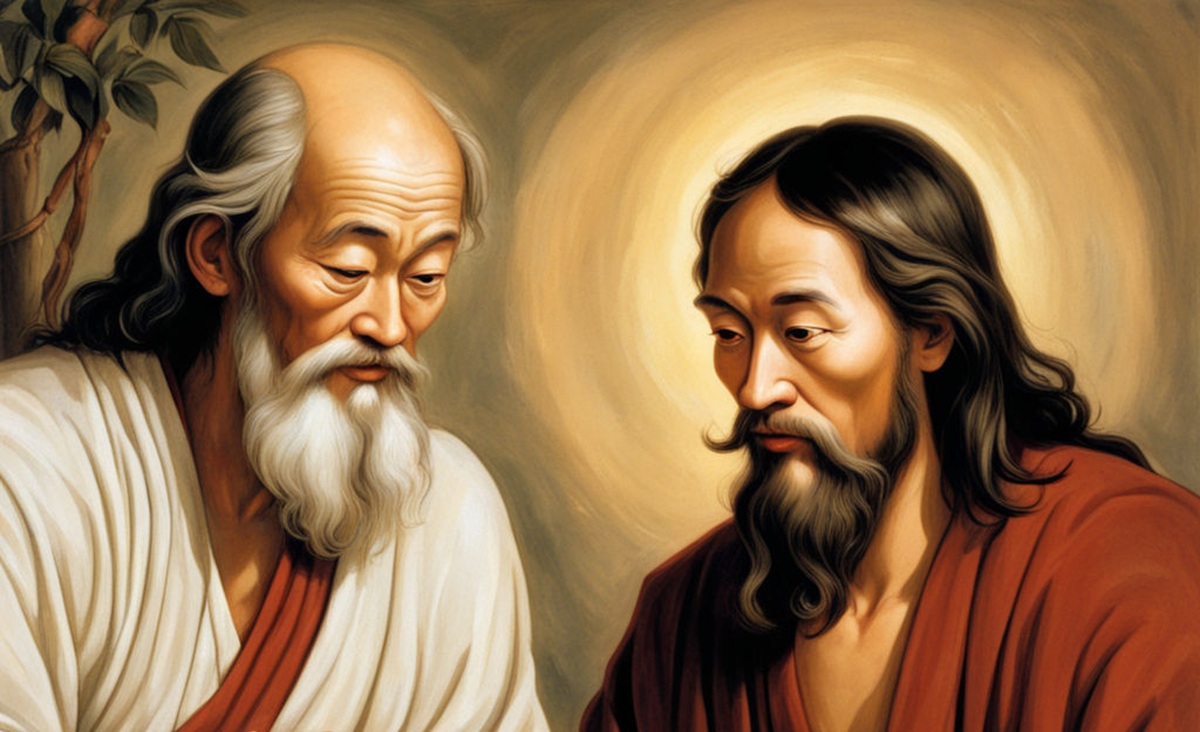Spiritual seekers need mystical models whose lives exemplify the qualities of a sage. Jesus and Lao Tzu demonstrate how to live in balance.

Living like a sage might seem like a lofty goal. But Taoist and Christian teachers show it’s not so much a matter of attaining great heights as settling into the depths of Ultimate Being. You can live like a sage if you learn to be subtle, discerning, alert, courteous, fluid and receptive. The fifteenth verse of Lao Tzu’s Tao Te Ching offers a clue:
Lao Tzu’s Tao Te Ching, Verse 15
J.H. McDonald Translation
The Sages of old were profound
and knew the ways of subtlety and discernment.
Their wisdom is beyond our comprehension.
Because their knowledge was so far superior
I can only give a poor description.
They were careful
as someone crossing a frozen stream in winter.
Alert as if surrounded on all sides by the enemy.
Courteous as a guest.
Fluid as melting ice.
Whole as an uncarved block of wood.
Receptive as a valley.
Turbid as muddied water.
Who can be still
until their mud settles
and the water is cleared by itself?
Can you remain tranquil until right action occurs by itself?
The Master doesn’t seek fulfillment.
For only those who are not full are able to be used
which brings the feeling of completeness.
The Value of a Good Story
When it comes to sagelike wisdom, nothing beats the parables of Jesus. He was a teacher who knew the value of a good story to get his point across. But many became frustrated because he always taught in parables. Matthew 13:10-13 says:
Then the disciples came and asked him, “Why do you speak to them in parables?” He answered, “To you it has been given to know the secrets of the kingdom of heaven, but to them it has not been given. For to those who have, more will be given, and they will have an abundance, but from those who have nothing, even what they have will be taken away. The reason I speak to them in parables is that ‘seeing they do not perceive, and hearing they do not listen, nor do they understand.’
A Coded Message
You might think that Jesus told his parables to make everything clear. When a preacher gives a sermon illustration, it’s generally so the hearer can understand. But Jesus’s teaching was subtle enough that spiritually minded people could grasp his meaning while those who were not truly seeking would wander away confused. This is why he frequently said, “Those who have an ear to hear, let them hear.” He communicated his message in code, and only for those who truly wanted to understand.
Perhaps this is why in his parables, Jesus never said, “The realm of heaven is such-and-such.” Instead, using similes and metaphors, analogies and stories he discussed what the kingdom of God was like. By doing so, he communicated that the realm of God was not a kingdom at all, but a sagelike way of living that tapped into the virtue of the universe.
A Subtle Message
Lao Tzu echoes the subtlety of Jesus when he says, “The sages of old were profound and knew the ways of subtlety and discernment. Their wisdom is beyond our comprehension. Because their knowledge was so far superior, I can only give a poor description.” Like Jesus, Lao Tzu avoided saying, “The Tao is such-and-such.” Instead, he used comparisons to say, “The Tao is like this or like that.” Thus, he could relay Ultimate Truth without painting himself into a corner. If you want to live like a sage, it’s best to learn how to express yourself with subtlety.
A Careful Message
Lao Tzu writes that the sages of old “were careful as someone crossing a frozen stream in winter. Alert, as if surrounded on all sides by the enemy. Courteous as a guest. Fluid as melting ice. Whole as an uncarved block of wood. Receptive as a valley. Turbid as muddied water.” Similarly, in the Gospel of Mark, we see Jesus communicating carefully as if tiptoeing across frozen water. He did not reveal himself as the Messiah to everyone. Jesus asked people to keep the messianic secret, telling them not to tell anyone of his miraculous work.
Sometimes, Jesus simply disappeared from the crowd. Other times, he moved secretly about the crowd, separate from his disciples, so he would not be recognized. Once, he sent his disciples to a festival, telling them that he would not attend. Later, he went to the festival secretly and without them, so as not to attract attention. Certainly, Jesus was a public figure, but he also knew the value of moving with subtlety. Jesus demonstrated that living like a sage means not making a big deal out of yourself.
Courteous as a Guest; Fluid as Melting Ice
Jesus was courteous as a guest. He visited the homes of saints and sinners alike, giving them his undivided attention. By visiting with people in their homes, he could meet them where they lived spiritually as well, apart from the prying crowd. He could be all things to all people, fluid as melting ice. To the spiritually sick he could be as a physician. To the wandering, he could be as a shepherd. He was the bread of life to the hungry. For the thirsty, he could be the living water. He could be all these things because he himself was whole as an uncarved block of wood.
Pu: The Uncarved Block
The uncarved block is the Taoist characteristic of pu. It means open and receptive, willing to be imprinted with whatever design the Carver wants to put upon it. For Jesus, pu meant he could meet people without expectations or agendas. He could allow them to determine what they needed from him without him imposing himself upon anyone. Pu is the quality of availability, willingness, and creativity that allows good things to flow effortlessly in all directions. This Christlike quality of pu is essential if you want to live like a sage.
Turbid, Yet Clear
The Tao Te Ching describes the sage as “turbid as muddied water,” yet able to be “still until his mud settles, and the water is cleared by itself.” We must understand that not even the sage is exempt from troubled times or troubling emotions. Turbid thoughts and feelings happen to everyone. But even in difficulty, the sage develops the ability to be tranquil until the right action occurs of its own volition.
Jesus demonstrated this turbidity in his Gethsemane prayer. Facing the terror of crucifixion, he wept and cried out to God, shedding many tears and sweating drops of blood. If it were possible, he said he would rather this cup passed from him. Yet, he prayed, “Not my will but Yours be done.” He was able to be still and know that God was in him and with him and through him. He was able to keep silent until his muddy waters cleared and the right action occurred by itself.
The Master Doesn’t Seek Fulfillment
The Tao Te Ching says, “The master doesn’t seek fulfillment. For only those who are not full are able to be used which brings the feeling of completeness.” Jesus never sought his own fulfillment. He sought instead the fulfillment of heaven’s will. He sought the fulfillment of other people. Jesus sought first the realm of heaven, and divine righteousness, and simply allowed everything he needed to come to him in its time. By emptying himself, he was able to be filled.
If you live your life like a sage, you do not need to seek your own fulfillment. Instead, when you help others live in peace your own satisfaction falls into place naturally. Even if your path of service leads to suffering, you can be like Jesus and allow your muddied waters to settle until they become clear. Therefore, “Let the same mind be in you that was in Christ Jesus,” who put himself last and served others first. You may think you’re losing everything by following this example—but if you walk this path, you have everything to gain.
Something to Ponder…
Take a few moments to enter into silent meditation. Do your best to focus on your breath, noticing the texture of the wind as it fills your lungs and becomes part of you. Feel the air as it escapes your lips and rejoins the universe. Whenever turbid thoughts come, imagine them as specks of mud floating in the water of your mind. Allow your mind to relax, watching those bits of mud settle to the bottom until you become clear. Recognize that everyone has muddy thoughts. Living like a sage doesn’t mean removing all obstructions. Instead, it means being calm enough to let your mud settle so you can see clearly.














